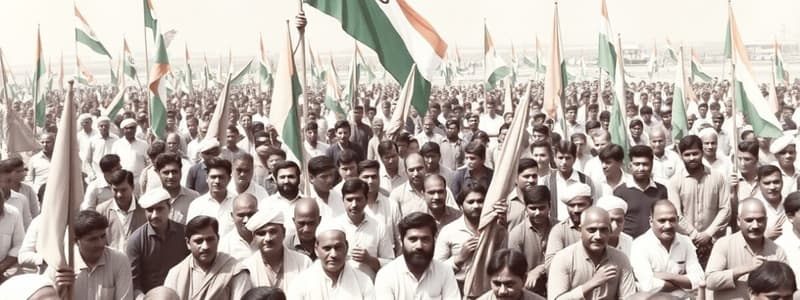Podcast
Questions and Answers
Which of the following statements accurately reflects the purpose of the Swadeshi movement?
Which of the following statements accurately reflects the purpose of the Swadeshi movement?
- To promote economic self-sufficiency by encouraging the consumption of Indian goods and boycotting British products. (correct)
- To reform the Indian education system by introducing Western curriculum and methods.
- To establish pan-Indian unity through the adoption of a single national language.
- To advocate for complete independence from British rule through armed rebellion.
What was the primary reason for the British government's decision to partition Bengal in 1905?
What was the primary reason for the British government's decision to partition Bengal in 1905?
- To appease the growing demands of Indian nationalists for greater autonomy and self-governance.
- To improve administrative efficiency by dividing a large province into smaller, more manageable units.
- To implement a policy of linguistic regionalism, creating separate provinces for different language groups.
- To sow discord and weaken the nationalist movement by dividing the Bengali people. (correct)
How did the Moderate leaders of the Indian National Congress differ from the Radicals in their approach to achieving political change?
How did the Moderate leaders of the Indian National Congress differ from the Radicals in their approach to achieving political change?
- The Moderates advocated for a federal system of government, while the Radicals desired a unitary system with a strong central authority.
- The Moderates believed in a gradual and constitutional approach within the existing British framework, while the Radicals favored more active methods like protests and boycotts. (correct)
- The Moderates focused on social reform and education, while the Radicals prioritized economic empowerment and industrialization.
- The Moderates were primarily drawn from the upper classes, while the Radicals were more representative of the working class and peasantry.
Which of the following statements best describes the impact of the Partition of Bengal on the Indian National Movement?
Which of the following statements best describes the impact of the Partition of Bengal on the Indian National Movement?
How did the "Do you know?" section of the text contribute to the understanding of the Indian National Movement?
How did the "Do you know?" section of the text contribute to the understanding of the Indian National Movement?
Why is Bankim Chandra Chattopadhyay's song "Vande Matram" considered significant within the context of the Indian National Movement?
Why is Bankim Chandra Chattopadhyay's song "Vande Matram" considered significant within the context of the Indian National Movement?
Which statement accurately describes the role of the Indian National Congress in the fight for independence?
Which statement accurately describes the role of the Indian National Congress in the fight for independence?
Which of the following was NOT a demand of the Moderate leaders of the INC?
Which of the following was NOT a demand of the Moderate leaders of the INC?
Flashcards
Indian National Congress (INC)
Indian National Congress (INC)
A political party formed in 1885 to promote Indian nationalism.
Moderates
Moderates
The early phase of Congress (1885-1905) focused on gradual reforms.
Prominent Moderate Leaders
Prominent Moderate Leaders
Influential leaders like Gokhale and Naoroji who led the moderate phase.
Radicals
Radicals
Signup and view all the flashcards
Partition of Bengal
Partition of Bengal
Signup and view all the flashcards
Swadeshi Movement
Swadeshi Movement
Signup and view all the flashcards
Vande Matram
Vande Matram
Signup and view all the flashcards
Prayer, Petition, Protest
Prayer, Petition, Protest
Signup and view all the flashcards
Study Notes
The Nationalist Movement (1870-1947)
- The British East India Company's rule ended in 1858 with Queen Victoria's Proclamation.
- Indians lacked political representation and policies were formulated without their input.
- The Indian National Movement emerged from this resentment, with various political associations forming.
Formation of the Indian National Congress (INC)
- The INC was formed in 1885 by A.O. Hume (a retired British official).
- It was supported by 72 educated Indian delegates from different regions.
- The first meeting was held in Bombay, under the presidency of W.C. Bonnerjee.
- The Congress gradually became a key force in the National Movement (1885-1947).
- Early Congress leaders (Moderates, 1885-1905) had faith in the British.
- Their goals included representative institutions, positions for Indians in administration, maintaining Indian industries and handicrafts, and stopping the drain of wealth to Britain.
- Moderates focused on appeals rather than action (prayer, petition, and protest).
Moderate Leaders
- Prominent leaders included Gopal Krishna Gokhale, Dadabhai Naoroji, Surendra Nath Banerjee, Pheroz Shah Mehta, Mahadev Govind Ranade, Badruddin Tayabji.
Difficult Economic Times
- Plague and famine caused significant hardship in India during this period.
Rise of Radicalism
- Leaders like Aurobindo Ghosh, Lala Lajpat Rai, Bal Gangadhar Tilak, and Bipin Chandra Pal emerged.
- They advocated for actions instead of appeals.
- Radicals used protests, hartals (strikes), and slogans to promote Indian culture and Hinduism.
Partition of Bengal
- Lord Curzon partitioned Bengal in 1905.
- The British aimed to weaken the Indian National Movement and collect revenue.
- India's partition was met with protest and demonstrations.
- Swadeshi, boycott, and national education movements were used to achieve Swaraj (self-governance).
- Indians boycotted foreign goods and prioritized using home-made products.
- The slogan "Swaraj is my birthright!" became popular.
- Participation of many women in the movements also noteworthy.
Studying That Suits You
Use AI to generate personalized quizzes and flashcards to suit your learning preferences.




